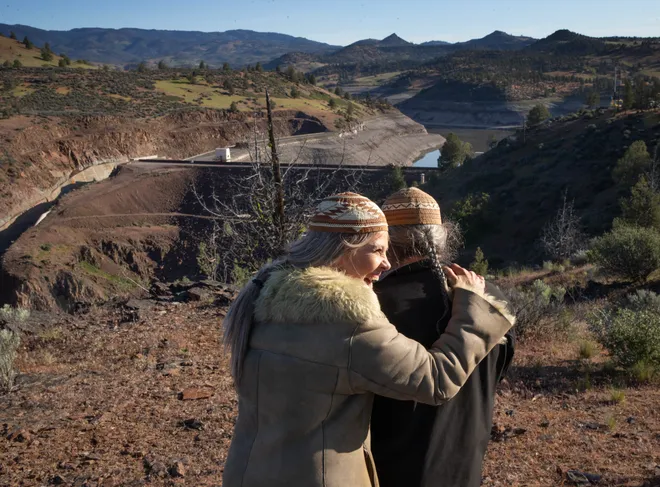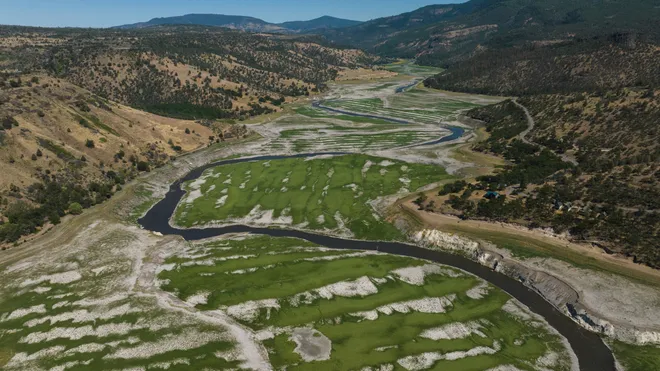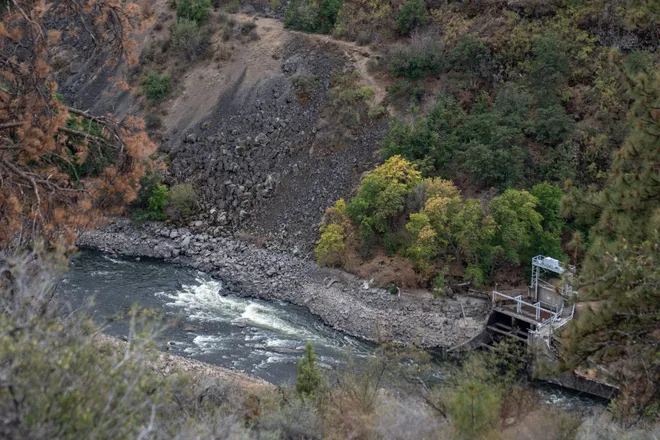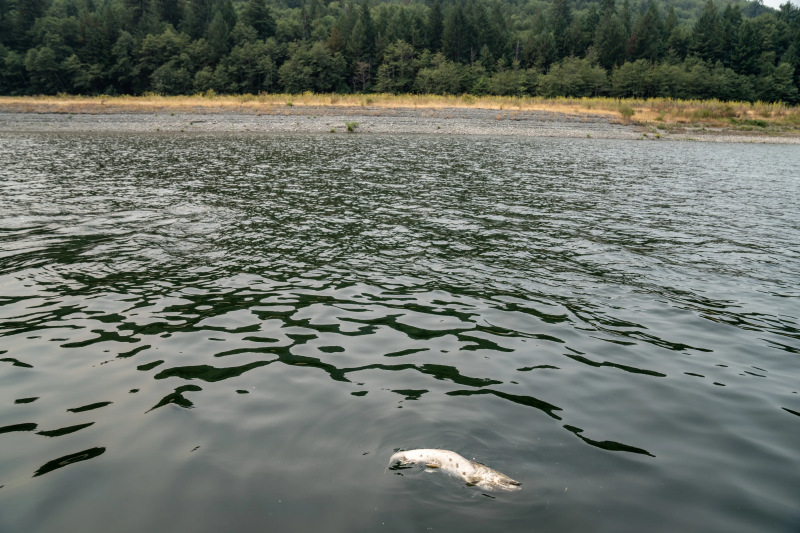Shasta tribe will reclaim land long buried by a reservoir on the Klamath River
As work proceeds to remove four dams along the Klamath River, more than the salmon runs will be restored: The lands long buried by the now-drained reservoirs will be reclaimed by the people who were robbed of them more than 100 years ago.
The Shasta Indian Nation celebrated Tuesday as California Gov. Gavin Newsom returned about 2,800 acres of the tribe's most sacred and culturally important lands that were drowned by the Copco I dam in the early 20th century. The date also marked the fifth anniversary of a historic apology made to California tribes by Newsom.
It's the latest chapter in the nation's largest-ever dam removal.
Christina Snider-Ashtari, tribal affairs secretary and head of the Governor's Office of Tribal Affairs, said Newsom personally delivered the news to the tribe during a visit to review the dam removal process on June 5.
The move to return lands to the Shastas was also supported by Siskiyou County. In November, the county board of supervisors unanimously voted to send a letter of support to the California Department of Fish and Wildlife on the tribe's request.

“The tribe is traditionally and culturally affiliated to these lands,” the letter stated, “and we believe that returning ownership of certain Parcel B lands will be a positive and important step. It is also the County’s view that Shasta Indian Nation will be good neighbors to the residents and other property owners in the area.”
Over the next few months, Snider-Ashtari said, the state's natural resources and fish and wildlife agencies will be working with Shasta officials to develop the exact legal documents to finalize the land transfer. That will include preparation of management plans, MOUs, conservation and public access easements, and a wide variety of other legal documents.
Snider-Ashtari, an enrolled member of the Dry Creek Rancheria Band of Pomo Indians, said the action felt meaningful to her personally.
"For me as a California Indian to help facilitate the deal shows that the Truth and Healing Council is not just an apology from the governor and a talking circle," she said. "It shows that your hope is not unfounded."

She said she is also hopeful that the state can continue to accomplish more for Indigenous peoples. And, Snider-Ashtari is hopeful that the state's citizens can see the value in uplifting the pathways and futures of California tribes as a step in jointly stewarding lands.
Tribe's hard-won lands lost again to dams
For millennia, or since time immemorial, the Shasta people have inhabited a region in Northern California from Seiad Valley east, surrounded by the Klamath, Scott and Shasta rivers and northeast to Jenny Creek and into southern Oregon.
The Kikacéki and Kutarawaxu bands of Shastas lived and worked on the lands surrounding the Klamath River about 35 miles northeast of Yreka. Kikacéki land also encompasses K’účasčas, a place sacred to tribal members around the mouth of Fall Creek.
Their first extended encounters with settlers occurred with the arrival of gold miners in the 1850s. Following the miners came farmers, ranchers, loggers and other settlers. Shastas in the region suffered greatly from a generation of massacres, forcible marriages and rapes, and the loss of their lands.
Shasta Chief Bogus Tom Smith labored to rebuild his community by obtaining Indian land allotments, marrying tribal members to landowners and other means. By the early 20th century, he had managed to put together some ranches close by each other to serve as restored homes for his people.
But the narrow valley with a meandering river threading its way along the bottomlands was also determined to be a good place to bring electricity to Siskiyou County and other parts of Northern California and Southern Oregon.
Just one thing stood in their way: the Shastas, whose reconstructed land base was directly in the area designated for the dams and the reservoirs that would feed water through the turbines. The people of the small tribe were removed from their homes through eminent domain.

The Siskiyou Electric Light and Power Company began constructing the first of the dams, Copco No. 1, in 1910. The company was reorganized as the California-Oregon Power Company, or Copco. Between 1910 and 1962, the company built three more dams, all to generate electric service.
The 300-member tribe has fought to get at least part of their ancestral lands back ever since.
Dams come down, hope for land and salmon return rises
In addition to the loss of Indigenous lands, the dams also proved catastrophic for salmon, steelhead and other migratory fish since a large portion of their spawning sites were blocked by concrete and rebar.
For decades, tribes along the Klamath who have depended on a clean, free flowing river and the fish that once choked the waters have fought their own battle to remove the dams, which also had become breeding waters for toxic blue-green algae, killing fish and fouling waters far downstream.
Those efforts came to fruition in 2022 with the final enactment of the dam removal agreement that paved the way for the nation's largest-ever dam deconstruction. Among other provisions, the lands previously owned by PacifiCorp, the dams' last owner, were transferred to the states of California and Oregon or a designee by the state to be managed for public interest purposes.
The Shasta Indian Nation formally requested the return of the lands known as "Parcel B" lands that had been drowned under the Copco I dam during the process.
Newsom returned that land plus the sacred site of K’účasčas, effective with the completion later this year of the dam removal by the Klamath River Restoration Corporation, the nonprofit brought on to oversee the project.
The land return is of particular interest because the Shasta Indian Nation is the band of Shasta people not federally recognized. That's due to events peculiar to California history.
Several bands of Shastas, known as "Upper Klamath" of the Shasta and Scott rivers, signed onto the third of 18 treaties negotiated with California tribes with agent Redick McKee in November 1851.

In return for ceding all "right, title, claim or interest of any kind which they or either of them have to the lands they now occupy, and to all other lands or soil in California" to the U.S., they would receive reservation lands.
The U.S. Senate never ratified that or the other 17 treaties, instead locking them away in secret for decades. The Shastas, along with several hundred other California tribes, had to defend themselves against an ever-growing incursion of gold miners, farmers, loggers and other settlers determined to take land with little to no federal protection.
Because the Shastas whose land had been taken for the dams had no land base when the Indian Reorganization Act was signed in 1934, they were left off the list of tribes deemed eligible to receive services from the Bureau of Indian Affairs or other government agencies, a process known as federal recognition.
Many tribes lost lands or lost their status during the termination era in the mid-20th century when the federal government was trying to reduce the number of tribes it was serving. As a result, about one-third of California tribes lack recognition.
In addition to offering the apology Newsom also issued an executive order establishing the California Truth and Healing Council to study and clarify the relationship between the state and "California Native Americans."
'This is justice for the Shasta people'
The tribe is formulating plans for the land, including a cultural center and public trail detailing Shasta history to satisfy the public access requirement. Unlike other land returns, this one comes without restrictions on other development such as housing. The Shasta Indian Nation is taking advantage of that by starting to develop a plan to honor Bogus Tom's original goal of rebuilding a home for the entire community.
There are no plans for a casino, one tribal spokesperson said. But they will be restoring traditional food, medicinal and ceremonial plants to the land, plus re-establishing basketry plants. Those activities are expected to generate jobs and business opportunities, plus a reliable source of healthy foods. The Shastas also relied on salmon and once the population has been restored, they may restart traditional fishing.
Candice Difuntorum, Shasta's vice-chairman, said the tribe's vision is cultural revitalization, education and landscape stewardship.
“The dam removal has exposed 35 miles of river that hasn’t seen the light of day for over 100 years, and we look forward to restoring the river, our lands, our ceremony and people."
“Today is a turning point in the history of the Shasta people," said Shasta Indian Nation Chairman Janice Crowe. She said what the Shasta people have experienced over the last 150 years has been a painful story to tell.
"Now we can return home, return to culture, return to ceremony and begin to weave a new story for the next generation of Shasta, who will get to call our ancestral lands home once again.
"This is justice for Shasta people."
Debra Krol reports on Indigenous communities at the confluence of climate, culture and commerce in Arizona and the Intermountain West. Reach Krol at debra.krol@azcentral.com. Follow her on X, formerly Twitter @debkrol.
Coverage of Indigenous issues at the intersection of climate, culture and commerce is supported by the Catena Foundation.
Disclaimer: The copyright of this article belongs to the original author. Reposting this article is solely for the purpose of information dissemination and does not constitute any investment advice. If there is any infringement, please contact us immediately. We will make corrections or deletions as necessary. Thank you.





